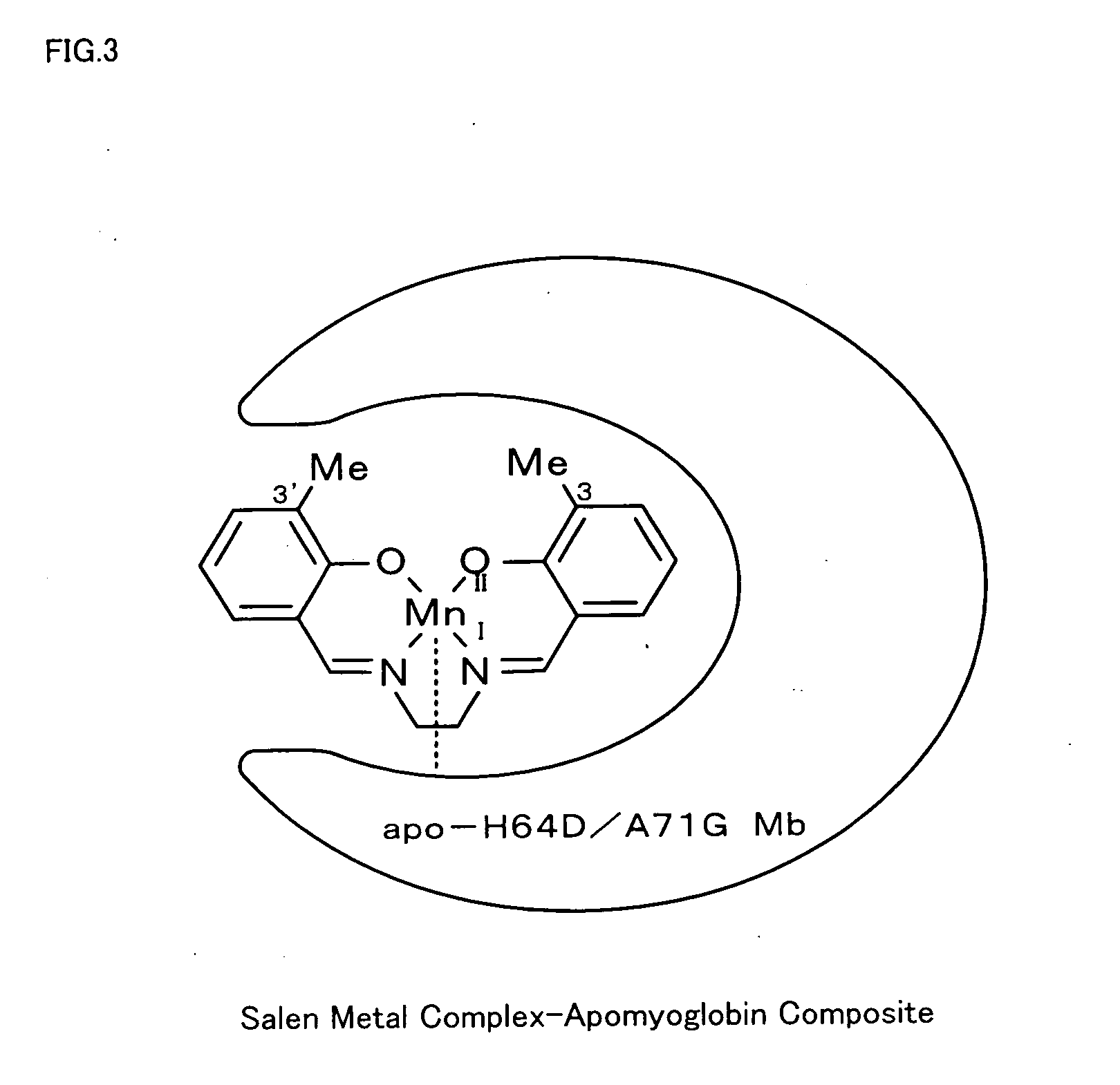Metal complex-protein composite and oxidation catalyst
a metal complex and composite technology, applied in the direction of organic compound/hydride/coordination complex catalyst, physical/chemical process catalyst, peptide/protein ingredient, etc., can solve the problems of insufficient oxidation reactivity and enantioselectivity of the art composite of the salophen complex, and achieve the effect of enhancing the rate of an oxidation reaction and the enantioselectivity of a reaction product, accelerating oxidation reactions, and economical efficiency
- Summary
- Abstract
- Description
- Claims
- Application Information
AI Technical Summary
Benefits of technology
Problems solved by technology
Method used
Image
Examples
example 1
[0022] 3,3′-Me2-salen ligand (see FIG. 1) was synthesized first. The procedure of synthesis dissolved 0.27 g (2 mmol, Sigma-Aldrich Inc.) in 10 ml of ethanol, added 0.06 g (1 mmol) of ethylenediamine dropwise to the solution, and refluxed the mixed solution at 90° C. for 2 hours. Removal of the solvent by evaporation gave the yellow product, 3,3′-Me2-salen ligand.
[0023] [MnIII(3,3′-Me2-salen)]+BF4− (see FIG. 2) was then synthesized. The procedure of synthesis dissolved 50 mg (0.16 mmol) of the synthesized 3,3′-Me2-salen ligand in 8 ml of ethanol, added 33 mg (0.16 mmol) of MnCl2.H2O to the solution, and refluxed the mixed solution at 85° C. for 4 hours. The refluxed solution was stirred overnight at room temperature and was concentrated to give the brown precipitate, [MnIII(3,3′-Me2-salen)]+Cl−. The procedure then dissolved 15 mg (0.04 mmol) of [MnIII(3,3′-Me2-salen)]+Cl− in 5 ml of methanol, added 7.7 mg (0.04 mmol) of AgBF4 to the solution, and refluxed the mixed solution at 75° ...
example 2
[0027] According to the procedure of Example 1, 3,3′-Et2-salen ligand (having Et at the 3-position and the 3′-position of FIG. 1), [MnIII(3,3′-Et2-salen)]+BF4− (having Et at the 3-position and the 3′-position of FIG. 2), and a corresponding salen metal complex-apomyoglobin composite were synthesized. The observed value of the resulting composite by ESI-TOF MS was 17669.6, which well agreed with the calculated value 17671.1. The resulting salen metal complex-apomyoglobin composite was used for asymmetric oxidation reaction of thioanisole. The results of the reaction are shown in FIG. 5.
example 3
[0028] According to the procedure of Example 1, 3,3′-Pr2-salen ligand (having n-Pr at the 3-position and the 3′-position of FIG. 1), [MnIII(3,3′-Pr2-salen)]+BF4− (having n-Pr at the 3-position and the 3′-position of FIG. 2), and a corresponding salen metal complex-apomyoglobin composite were synthesized. The observed value of the resulting composite by ESI-TOF MS was 17698.5, which well agreed with the calculated value 17699.1. The resulting salen metal complex-apomyoglobin composite was used for asymmetric oxidation reaction of thioanisole. The results of the reaction are shown in FIG. 5.
PUM
| Property | Measurement | Unit |
|---|---|---|
| distance | aaaaa | aaaaa |
| temperature | aaaaa | aaaaa |
| temperature | aaaaa | aaaaa |
Abstract
Description
Claims
Application Information
 Login to View More
Login to View More - R&D
- Intellectual Property
- Life Sciences
- Materials
- Tech Scout
- Unparalleled Data Quality
- Higher Quality Content
- 60% Fewer Hallucinations
Browse by: Latest US Patents, China's latest patents, Technical Efficacy Thesaurus, Application Domain, Technology Topic, Popular Technical Reports.
© 2025 PatSnap. All rights reserved.Legal|Privacy policy|Modern Slavery Act Transparency Statement|Sitemap|About US| Contact US: help@patsnap.com



